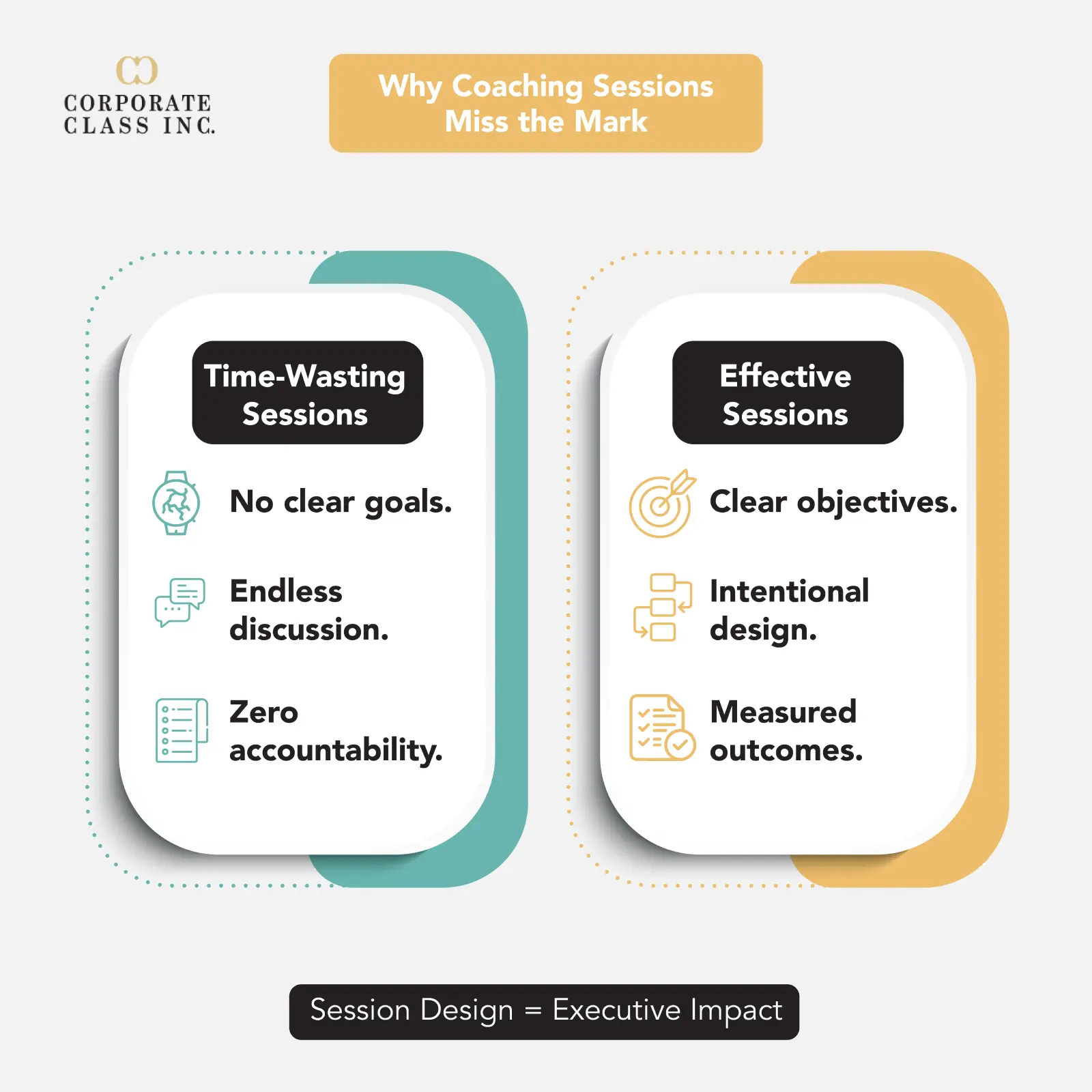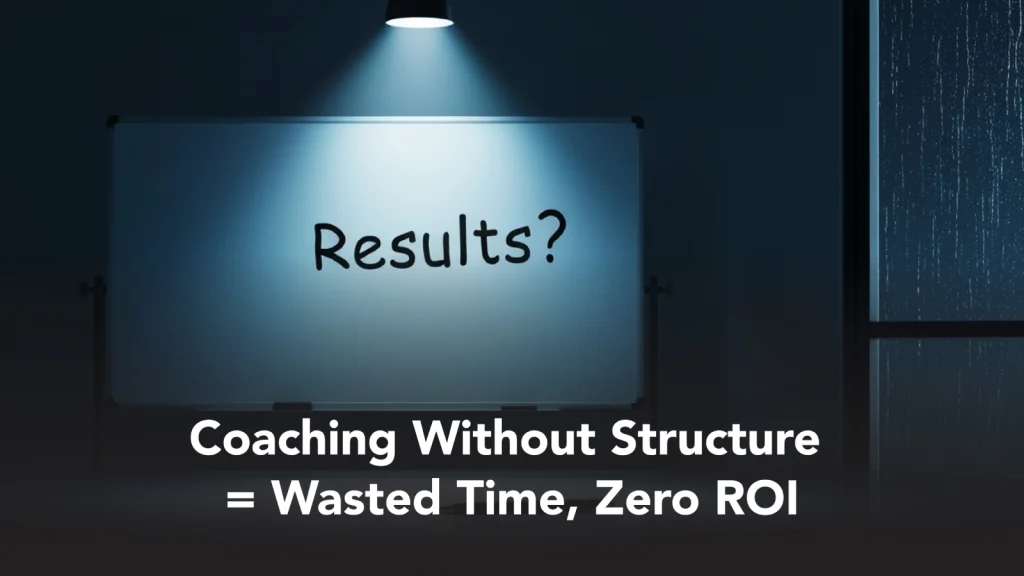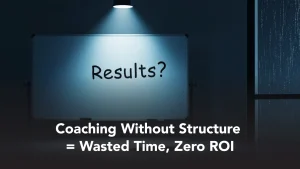Most executive coaching sessions miss the mark because they lack clear structure and measurable goals. A meeting filled with good conversation can feel productive in the moment, yet without intentional design, it rarely translates into lasting impact. Leaders leave the room with ideas but no pathway, insight but no action. This article explains what separates effective sessions from wasted ones, why session design matters, the cost of neglecting it, and how proven frameworks ensure executives achieve tangible performance results.
Key Takeaways
- Coaching sessions without intentional design fail to deliver sustainable leadership growth.
- Structured approaches increase executive engagement, accountability, and ROI.
- Proven frameworks for session design transform coaching from theory into measurable outcomes.
Identifying What Makes Executive Coaching Sessions Truly Effective vs. Time-Wasting
Executive coaching works when the session creates clarity, challenges assumptions, and defines concrete actions. An effective coach balances questioning with guidance, moving the executive from self-awareness to deliberate behavior change. Without this balance, the session becomes an expensive conversation with no measurable progress.
The difference between effective and time-wasting often comes down to three elements:
- Clear objectives tied directly to business outcomes.
- Measurable goals that extend beyond “good discussion.”
- Accountability mechanisms that track actions over time.
Executives operate with limited bandwidth. Every coaching hour must deliver measurable value. A structured, goal-driven session respects that reality while producing insights that executives can apply immediately in decision-making, communication, and leadership behaviors. Companies investing in coaching should measure sessions against results, not just satisfaction surveys.
Designing Coaching Sessions with Intentional Structure to Drive Outcomes
Strong session design starts before the first question is asked. Coaches must establish desired outcomes with the executive, align on key priorities, and set expectations for the process. When these foundations are in place, every conversation builds toward measurable improvement.
A well-structured session creates momentum through a repeatable rhythm:
- Opening check-in to establish focus.
- Exploration of challenges using guided questioning.
- Action planning with clear steps and timelines.
The rhythm eliminates drift and ensures the session ends with tangible commitments. Executives leave with clarity on what must happen next and a practical framework for accountability. That sense of direction is what translates conversation into measurable leadership impact.
The truth is simple: an executive coaching program that lacks structure delivers little more than dialogue. Structured design ensures every session becomes a strategic tool that drives leadership capability forward.
Learning the Hidden Costs of Unstructured Coaching at the Executive Level
Unstructured coaching carries costs that reach far beyond the coaching fee. Senior leaders have limited availability, and their time represents one of the most valuable organizational resources. When a session lacks structure, that time is wasted immediately, and the bigger loss lies in the absence of progress that should have followed.
Executives who repeatedly attend sessions with no design often disengage. They stop seeing coaching as credible, which reduces trust in the process. This erosion impacts both the leader’s motivation and the company’s willingness to invest in future coaching.
The International Coaching Federation reported that companies experience an average ROI of seven times the investment when coaching is structured with measurable outcomes. Compare that with the wasted investment of unstructured sessions, and the choice becomes obvious. Structure is not a preference; it’s the only way to generate results worth the investment.

Exploring What Elite-Level Coaching Session Design Really Entails
Elite-level coaching requires precision. It connects leadership development with measurable business performance, ensuring that executives don’t just gain insight, they act on it. At this level, coaches engineer sessions with intentional design rather than improvising in the moment.
Elite session design typically includes:
- Alignment with corporate objectives at the start of every engagement.
- Tailored frameworks that adapt proven coaching models to the executive’s context.
- Continuous measurement of both behavioral changes and business results.
This approach separates world-class coaching from surface-level conversation. Leaders who experience elite design report higher engagement, stronger behavioral shifts, and measurable improvements in team performance. If you want to see how high-impact coaching connects directly to executive presence and leadership growth, explore Executive Presence and Leadership Coaching.
Applying Proven Frameworks for Maximizing Executive Engagement and Performance
Frameworks matter because they combine consistency with flexibility. Executives thrive when their coaching process follows a structured model that still adapts to their specific needs. Proven frameworks provide guardrails that keep the session outcome-driven while still allowing room for customization.
Practical frameworks often integrate:
- 360-degree feedback tools.
- Strengths and blind spot mapping.
- Behavioral goal setting with quarterly reviews.
When frameworks are applied consistently, they create accountability loops that drive visible change. Executives don’t just attend sessions, they act, follow through, and deliver improved results across their teams. For organizations, this creates measurable ROI and establishes coaching as a strategic advantage rather than a “nice to have.” See how structured coaching frameworks directly align with organizational growth through For Businesses.
FAQ
What is the most common reason coaching sessions fail?
Sessions fail when they lack structure, measurable goals, and accountability. Leaders leave with ideas that never become actions, which limits ROI.
How can executives prepare for a coaching session?
Executives should clarify desired outcomes in advance, bring current challenges, and commit to implementing agreed action steps. This preparation increases the value of every coaching session.
What role does session design play in long-term coaching success?
Session design ensures consistency, creates measurable progress, and connects leadership growth with organizational results. Without design, coaching quickly loses momentum.
Designing Session Design to Drive Executive Impact
Designing sessions for executive coaching can mean the difference between wasted time and tangible leadership growth. Executives who experience intentional structure engage more fully, commit to follow-through, and drive stronger organizational results. Businesses that invest in structured coaching amplify ROI, build leadership credibility, and accelerate progress company-wide. The next step for your organization is clear: prioritize coaching that is intentionally designed for executive impact.





